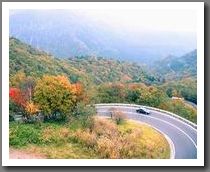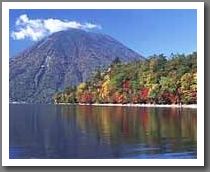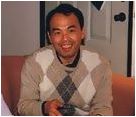Four Seasons of Nikko Guide you to Nikko
I tell you myself and Nikko.
I work at hotel in Chuzenji area,
living city of Nikko.commute every
day to Chuzenji area through
Iroha-Saka.

About Hotel that I work at
HOTEL SHIKISAI started 11
years ago, and renewaled
lastyear. located near the lake
in the woods.

Hotel Shikisai located 5 minutes
distance from Lake-Cyuzenji.
Msot beautifl lake in Japan,
many falls are there before
and after of this lake.

|
Shrines and Temples of Nikko |
Brief Description
The shrines and temples of Nikko, together
with their natural surroundings, have for
centuries been a sacred site known for its
architectural and decorative masterpieces.
They are closely associated with the history
of the Tokugawa Shoguns.
Justification for Inscription Criterion (i)
The Nikko shrines and temples are a reflection of architectural and artistic genius; this aspect is reinforced by the harmonious integration of the buildings in
a forest and a natural site laid out by man.
Criterion (iv)
Nikko is a perfect illustration of the architectural style of the Edo period
as applied to Shinto shrines and Buddhist
temples.
The Gongen-zukuri style of the two mausoleums, the Toshogu and the Taiyu-in Reibyo, reached the peak of its expression
in Nikko, and was later to exert a decisive influence.
The ingenuity and creativity of its architects and decorators are revealed in an
outstanding and distinguished manner.
Criterion (vi)
The Nikko shrines and temples, together
with their environment,are an outstanding example of a traditional Japanese religious centre, associated with the Shinto perception of the relationship of man with nature, in which mountains and forests have a sacred meaning and are pobjects of veneration, in a religious practice
that is still very much alive today.
|
Ramsar Oku-Nikko-shitsugen. |
The site is composed of Senjogahara, Odashirogahara and Yunoko at 1400m asl.
in altitude surrounded by mountains.
Senjogahara is one of the largest high moors in Honshu Island with more than 100 species of swamp plants like cotton grass and Japanese azalea.
The vegetation of Odashigahara shows characteristics of moor and grassland succession;
Potential threats to Senjogahara are sediment inflow, reduction of inflow, constructions of facilities disconnecting inflow from upstream, Conservation measures regularly conducted by local
organixations are nature walks, control of
alien species, control foraging by deer, and
capacity building training for youth.
Ramsar site no. 1553. whereas Yunoko is a freshwater lake with hot springs in the same watershed, almost in pristine condition and an attractive tourist spot.
The area is an important breeding site for summer birds, mostly Latham's Snipe Gallinago hardwickii and Stonechat Saxicola torquata.
During winter, the site is visited by many migratory waterfowls including Mallard, Wigeon, Tufted Duck and Smew.
Colour change of decidous trees in autumn, traditionally called 'Koyo', is cherished by
the Japanese for its landscape beauty.
|
Take easy and rest at hotel in the woods of |
This is area that you can see family
of dears at garden front of your room,
or front of open-air bath quite often.
Wild life of this Nikko Area are reserved
as regulation of Nikko National Park,
and development and out-door publicity are
contoroled.
History behind of Chuzenji Area
Not only see the great site of Nature and
man-made structure, but also look back history
of man who gave great spirit and dream to
Chuzenji and even for Japan!.
|
One man started The U.K style fly-fishing here in this lake, as he stock a lake with trout. This is first time for fly-fishing in Japan. Chuzenji-Lake is considered as a "sacred ground" of fly-fishing in Japan, because of this matter. His name is Thomas B. Glover (1838 - 1911). |
if you have any question
about Nikko area.
I can help for you.
